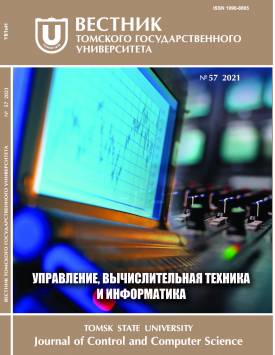Implementation of the deviation control principle in models of mechanical engineering production based on Petri nets
The presented article describes an approach to solving control problems for discrete-type production systems based on preliminary simulation modeling with Petri nets. The main idea of the work is to use the basic principles of the theory of automatic control in models based on Petri nets, in particular, the implementation of state feedback in the simulation model. The expediency and prospects of using the feedback mechanism for solving the problem of control of simulation experiments are substantiated. The problem of optimization of assembly production in the terminology of the theory of automatic control is formulated. The mechanism for creating feedback in the structure of the network model is determined. An algorithm for the joint functioning of the control object model and the control device for the class of temporary Petri nets has been developed. Based on the developed theoretical provisions, a test example is presented that characterizes the positive effect of their application. A variant of forming a control device based on logical functions with expertly formulated rules has been tested. The presence of assembly production at most machine-building enterprises determines the high practical significance of the developed approach. The developed approach to process optimization develops the theory of Petri nets, makes it more suitable for modeling complex systems with a branched structure and a large number of interconnections between system elements. The most universal approaches of control theory are used, which allows us to speak about the required degree of invariance to the features of specific systems and the maximum replicability of the approach. The main disadvantage of the proposed approach is that it is impossible or at least difficult to propose a method for synthesizing a control device according to formal requirements, as is customary in the theory of automatic control. This is due to the need to interpret the elements of the simulation model, to analyze the mechanisms of mutual influence of the elements of the Petri net. The direction of further research on the topic of the article can be to determine the effectiveness of the proposed approach for various classes of systems. Using the approach for more complex systems and processes will obviously require more advanced mathematical tools to implement control laws, for example, artificial neural networks, which have proven themselves well in the face of difficulties in formalizing the mathematical dependencies of factors.
Keywords
Petri net, deflection control, network controller, logic function, transientAuthors
| Name | Organization | |
| Sochnev Aleksey N. | Siberian Federal University | asochnev@sfu-kras.ru |
References

Implementation of the deviation control principle in models of mechanical engineering production based on Petri nets | Vestnik Tomskogo gosudarstvennogo universiteta. Upravlenie, vychislitelnaja tehnika i informatika – Tomsk State University Journal of Control and Computer Science. 2021. № 57. DOI: 10.17223/19988605/57/2
